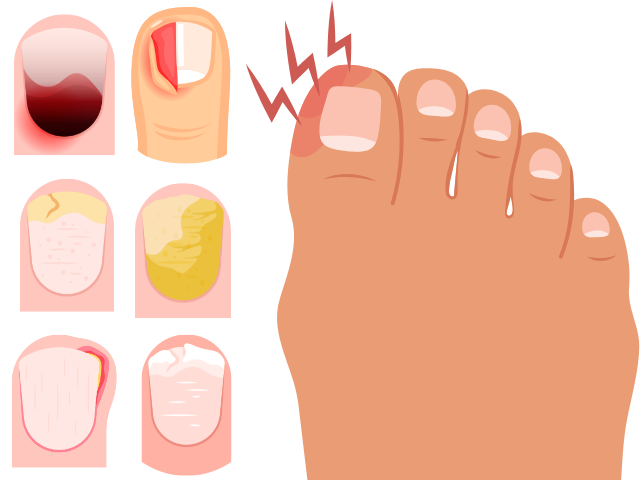At KK Virat Hospital, Karimnagar, we provide expert treatment for ingrown toenails, ensuring effective and minimally invasive solutions for long-lasting relief. Our experienced specialists use the latest techniques to provide safe and painless removal of ingrown toenails.
What is Ingrown Toenail Removal?
Ingrown toenail removal, also known as matricectomy, is a procedure where part or all of the nail matrix (the tissue from which the nail grows) is removed. This treatment is recommended for chronic or severe cases where non-surgical methods have failed. Our doctors choose the most suitable technique—chemical, electrosurgical, or surgical—based on the severity of the condition.

Risks of Leaving an Ingrown Toenail Untreated
If left untreated, an ingrown toenail can lead to:
- Infection: Redness, swelling, pus formation, and pain.
- Chronic Pain: Persistent discomfort, affecting mobility.
- Nail Deformity: Abnormal nail growth or loss of the nail.
- Serious Complications: Higher risks for diabetic patients, including ulcers and gangrene.
Early medical intervention can prevent severe complications and ensure faster recovery.
Ingrown Toenail Treatment Methods
Treatment depends on the severity of the condition:
- Foot Soaking: Warm water with Epsom salt to reduce swelling and pain.
- Nail Lifting: A small cotton piece is placed under the nail to help it grow properly.
- Antibiotics: Prescribed if an infection is present.
- Partial Nail Removal: The ingrown part of the nail is surgically removed under local anesthesia.
- Total Nail Removal: In severe cases, the entire toenail is removed to prevent recurrence.
Seeking timely medical attention can help prevent infections and long-term discomfort.
How is Ingrown Toenail Surgery Performed?
Ingrown toenail surgery is a quick, outpatient procedure that takes around 30 minutes:
- Local anesthesia is administered to numb the toe.
- The affected portion of the nail is surgically removed.
- If needed, a chemical (phenol) or laser treatment is used to prevent regrowth.
- The nail bed is cleaned and treated to prevent infection.
- A sterile dressing is applied to promote healing.
Patients can usually return home the same day and resume light activities soon after.
Techniques for Ingrown Toenail Surgery
Several surgical techniques are available based on severity:
- Radiofrequency Ablation: High-frequency energy is used to destroy the affected tissue.
- Partial Nail Avulsion: Removing the ingrown portion while preserving the rest.
- Total Nail Avulsion: Complete removal of the toenail in severe cases.
- Chemical Matricectomy: Using phenol to destroy the nail matrix and prevent regrowth.
- Laser Surgery: A laser removes the ingrown section while sealing blood vessels.
Our specialists choose the safest and most effective technique for each patient.
Risks & Complications of Ingrown Toenail Surgery
While generally safe, potential risks include:
- Infection if post-operative care is not followed.
- Bleeding, especially in diabetic patients.
- Scarring, which may vary based on healing ability.
- Numbness or tingling due to minor nerve damage.
- Anesthesia reactions, such as nausea or dizziness.
Following post-surgery care instructions minimizes these risks.
Post-Surgery Expectations & Recovery
Pain and swelling for a few days, managed with prescribed medications.
- Limited movement; avoiding pressure on the foot is recommended.
- Keeping the wound clean and dry to prevent infections.
- Gradual resumption of normal activities based on healing progress.
- Full recovery usually takes 3 weeks to 3 months, depending on the severity.
Regular follow-ups ensure proper healing and early detection of complications.
Benefits of Ingrown Toenail Surgery
- Immediate relief from pain and discomfort.
- Reduced risk of infection and future complications.
- Improved mobility and ability to wear shoes comfortably.
- Lower chances of recurrence with proper surgical techniques.
- Increased awareness of foot hygiene and nail care.
Cost of Ingrown Toenail Surgery in Karimnagar
The cost of ingrown toenail surgery at KK Virat Hospital varies based on:
- Condition of the Patient
- Hospital facilities and location
- Severity of the condition
- Technique used for treatment
- Doctor’s consultation and surgical fees
- Additional expenses (diagnostics, medications, post-op care)
For a personalized cost estimate, contact KK Virat Hospital today.
Stages of Ingrown Toenails
- Stage I – Inflammatory: Mild pain and swelling; treated with conservative methods.
- Stage II – Abscess Formation: Infection, pus, and nail fold overgrowth; requires medical intervention.
- Stage III – Hypertrophic Growth: Granulation tissue forms; surgical removal is needed.
- Stage IV – Severe Deformity: Complete nail bed coverage by hypertrophic tissue; advanced surgery is required.
Why Choose KK Virat Hospital for Ingrown Toenail Removal?
KK Virat Super Speciality Hospital in Karimnagar offers expert diagnosis, advanced treatment, and state-of-the-art facilities. Our team of highly skilled experts doctor’s provides personalized care and high success rates in surgeries, ensuring long-lasting relief and improved health for every patient.
Your Health, Our Priority – Book Your Consultation Today!
If you have been diagnosed with Ingrown Toenail Removal, trust KK Virat Hospital in Karimnagar for expert, minimally invasive treatment. Call us today or schedule your consultation online to receive world-class care with personalized attention.
Get Advanced Ingrown Toenail Removal at KK Virat Hospital, Karimnagar
- Call Us Directly: Get in touch with our medical coordinators to schedule an appointment with an expert urologist.
- Direct Visit: You can visit our hospital directly by carrying your previous medical records if you have a medical history. However, admission will be based on the doctor’s recommendation.
Is it possible to remove ingrown toenails at home?
Mild cases may be managed at home with warm soaks, cotton under the nail, and antibiotic ointments. However, severe or infected cases require professional treatment to prevent complications.
Who to consult for ingrown toenail removal?
You should consult a podiatrist, general surgeon, or dermatologist for proper diagnosis and treatment of ingrown toenails. KK Virat Hospital has experienced specialists for safe and effective toenail removal.
How can I contact Pristyn Care doctors for toenail removal?
You can visit the Pristyn Care website or call their helpline to book an appointment with a specialist for toenail removal.
Is ingrown toenail surgery covered by health insurance?
Yes, health insurance may cover ingrown toenail surgery, especially if it is medically necessary due to infection or chronic pain. Check with your provider for specific coverage details.
When can I walk after undergoing toenail removal surgery?
Most patients can walk immediately after surgery with minimal discomfort, but it is advisable to rest and limit activities for a few days to aid recovery.
Why are diabetic patients at high risk of having ingrown toenails?
Diabetic patients have poor circulation and reduced healing ability, making them more prone to infections, ulcers, and severe complications from ingrown toenails. Timely treatment is crucial.
How long does it take to recover from ingrown toenail surgery?
Recovery typically takes 2 to 4 weeks, depending on the severity of the condition and the surgical method used. Proper foot care speeds up healing.
What are the signs of an infected ingrown toenail?
Symptoms include redness, swelling, pus discharge, increased pain, and warmth around the affected nail. Seek medical attention if you notice these signs.
Can an ingrown toenail come back after surgery?
While surgery significantly reduces the risk of recurrence, improper nail trimming, tight footwear, or trauma can lead to ingrown toenails again. Follow post-surgery care guidelines to prevent recurrence.
What is the best way to prevent ingrown toenails?
Trim nails straight across, avoid tight shoes, maintain foot hygiene, and consult a doctor if you experience repeated ingrown toenails.


